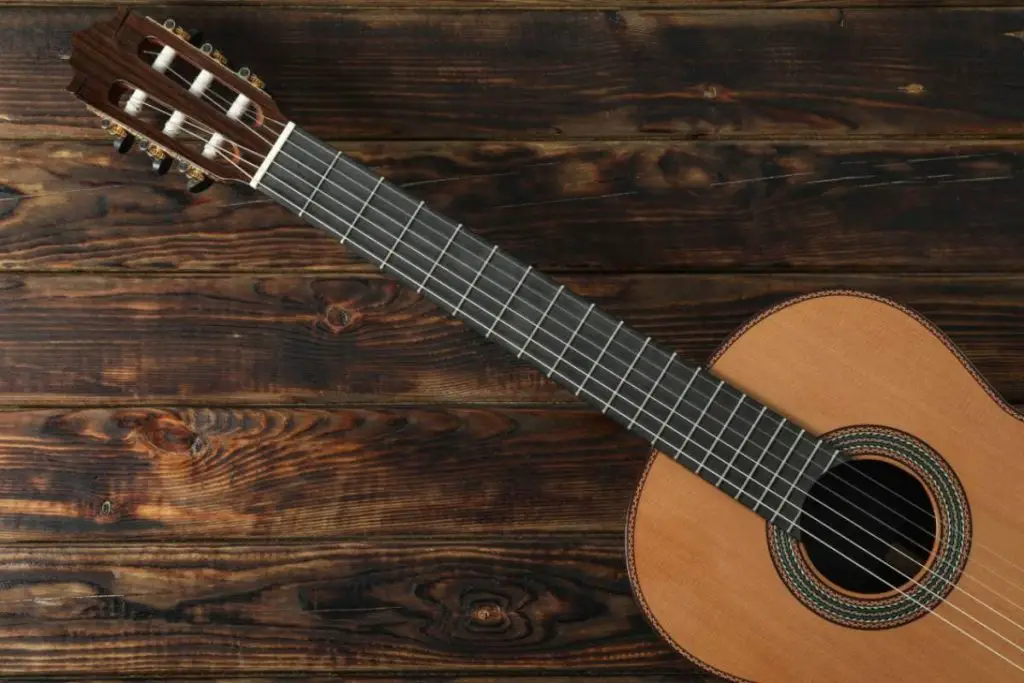Guitars come in various sizes and models to suit individual needs. However, certain aspects of an instrument’s build can affect your playing if it doesn’t fit your body type. How can you tell if the instrument is too big for you to handle?
Here are 6 signs your guitar is too big for you:
- You feel fatigued after a short while.
- You experience pain in your hands.
- You have awkward chord grips.
- The guitar’s scale length is too long for you.
- The guitar looks too big for your frame.
- Your elbow is raised up too high.
This article will tell you what to watch out for if you think your instrument feels too large for playing comfort. I’ll also discuss how to make playing more comfortable if you already own a big-sized guitar.
👇😀👇NOTE👇😀👇
If you want to find out what my recommended guitar gear is, then here is what I recommend on Amazon:
- Fender Cutaway Acoustic-Electric Guitar Bundle (MY FAVORITE GUITAR)
- Snark SN-8 Super Tight All Instrument Tuner (Easiest Tuner I’ve Used😏)
- 6 String Acoustic Guitar Capo (Best CAPO for quick changes)
- Dunlop Max Grip 1.0mm Nylon Picks (Thick Guitar Pick So You Don’t Lose Grip!)
- Universal Guitar Stand (Cheap & Minimalist Guitar Stand I Recommend)
- Levy’s 2″ Wide Quick Adjust Guitar Strap (Best Guitar Strap For Any Level)

1. You Feel Fatigued After a Short While
Feeling fatigued after playing your guitar for a short while could mean you have a guitar that’s too big for you. A bigger guitar equals a heavier guitar because it consists of more material.
Tiredness from carrying a guitar typically happens when you carry it with a strap around your shoulders. Even though straps help distribute the weight of your instrument across your body, a too-heavy load will still cause muscle fatigue and back pain.
Before you buy a guitar, ask to borrow a strap and see how long you can carry it on your shoulders. The guitar might be too big for you if you feel strained after five to ten minutes. In this case, it’s best to opt for smaller equipment or a guitar made with lightweight material.
Sitting vs. Standing While Playing
Choosing to sit or stand with a guitar boils down to personal preference and the musical style of each guitarist. Standing while playing an acoustic or electric guitar is common, but classical guitarists usually play seated.
Sitting while playing helps take some of the guitar’s weight off as it rests on your lap. However, guitarists who enjoy being on their feet carry the instrument’s weight in their arms and shoulders.
Sometimes, performers may alternate between standing and sitting because carrying a guitar for the concert isn’t feasible. Guitarists who switch between acoustic and electric instruments may also change their positioning for fun.
Try sitting down if your guitar is too bulky to carry, even with a strap. Many guitarists find that sitting down offers the most comfort while playing, but be careful not to hunch over your instrument too much.
Choosing a Guitar Strap for Your Size
A strap is pretty much an essential accessory for guitarists. Not only does it help hold your instrument up and closer to your body, but it also helps you distribute the total weight of your guitar efficiently.

There are several aspects to consider when choosing a strap:
- Length and width. Straps generally come with adjustable lengths, but it’s best to measure one that lets your guitar hang at the height you want. A wider strap is more comfortable than a narrower strap and offers greater support for a heavier instrument.
- Material. Guitar straps are made with various materials — leather is the most comfortable choice, and nylon is a cheaper alternative. Some straps also come with foam shoulder pads.
- Fit. The strap must feel good and comfortable enough for you to carry your instrument over long periods of playing. Try out the strap with your guitar to get the best fit for your setup.
2. You Experience Pain in Your Hands
If you experience pain from guitar playing, your hands could be too small to manage the instrument. Pain can come from various parts of your hands, including your wrist, palms, and fingers.
It’s common to have some pain when you’re adjusting to new hand positions while learning. However, pain that persists and prevents you from playing means that there’s something that needs to be changed.
Guitarists can suffer from Repetitive Strain Injury (RSI) when hands are forced into awkward positions during practice. The common guitar-related injuries are:
- Tendonitis
- Carpal tunnel syndrome
- Tennis elbow
- Arthritis
So, if you’re experiencing pain in parts of your fingers, wrists, or arms, you may need some intervention. Consult a clinician if the pain doesn’t subside or worsens over time. Alternatively, you may need to try out a reduced-size guitar and see if it solves the problem.
How Small Hands Affect Guitar Playing
You could be overstretching your fingers to play the notes if you have small hands and a big guitar. Some full-sized guitars have bigger distances between frets, affecting people with small hands and shorter fingers.
Also, the design of the guitar neck varies from brand to brand. Some guitars have thicker necks than others, making it harder for hands to wrap around the fretboard. In this case, you could strain your wrist from bending it too much to reach further across the frets.
Another thing to watch out for is arm strain. If you have shorter arms, you need to reach out more to play on a larger, longer guitar. This puts you at a technical disadvantage because you’re already stretching your muscles out, giving you less flexibility to move across the fretboard.

Stretching Exercises for Guitarists
The good news is that you can still play a full-sized guitar even if you have small hands, but you’ll need some help getting there. Before you think of swapping out for a smaller guitar, try some stretching exercises first.
Stretches also help you warm up your fingers and arms before you start playing. Knowing some basic exercises just in case you get a cramp, or before you perform complicated finger work, is a good idea. Physiotherapists recommend regular stretching for injury prevention and to help maintain nerve and muscle health.
Check out this YouTube video by Justin Sandercoe for some basic stretching exercises for guitarists with short fingers:
If stretching doesn’t work and you still feel discomfort after regular practice, you might need to look into getting a guitar with smaller dimensions.
3. You Have Awkward Chord Grips
Big guitars mean bigger everything, including the size of the frets and the width and thickness of the guitar neck (Related article: electric guitar body styles, necks, and frets for small hands). When you find it challenging to perform a basic chord, it’s a significant indicator that the guitar is the wrong size for you.
Although it’s possible to train yourself to play chords on a bigger guitar eventually, some people are simply unable to do so because of how their hands are shaped. Everyone’s body is different — sometimes, a smaller instrument is the best alternative if you can’t perform basic chords.
But how do you tell if a chord feels awkward to play? Well, your fingers might not be able to stretch far enough to fret a full chord.
This commonly occurs when you play barre chords, which are chords that require your index finger to span across a single fret over all six guitar strings. Other times, you could have trouble fretting if the chord stretches across more than two or three frets.
Tips for Guitarists With Small Hands
Who says people with tiny hands can’t play guitar? Many children start with a full-sized guitar because it helps them learn how to manage the size, or their hands may be naturally suited to an adult-size instrument.
If you want to learn how to adapt to a larger guitar, here are some tips to help you have an easier time:
- Position your right wrist forward. Moving your wrist forward allows you to position more of your fingers over the frets. However, be careful if you experience arm pain, as this could mean you’re straining your wrist too much.
- Buy a guitar with a C-shaped neck. C-shaped necks have the thinnest width, making it easier for small palms to curve around the fretboard. Watch out for U- and D-necks, which are thicker and less favorable for little hands.
- Hold your guitar closer to your body. Having your guitar close to your torso means more of your arms are around the instrument, giving you greater reach. If you’re using a strap, consider adjusting your guitar higher so your wrist doesn’t need to bend outwards too much.
- Tuck your thumb under the fretboard. Sometimes, players tend to let their thumb hang or wrap over the top of the neck. Practice positioning your thumb directly under the fretboard so your fingers will have more freedom to move across the frets.
4. The Guitar’s Scale Length Is Too Long for You
The scale length measures the distance between the nut and the bridge of a guitar. This measurement varies between models, so everyone can choose a size that feels the most comfortable for them.
Scale lengths are designed based on the dimension of the guitar — smaller guitars have shorter necks than larger guitars and vice versa. A tall person with large hands may find guitars with short scale lengths uncomfortable since the hands will be more cramped together.

If you find that the scale length of a guitar feels too long, this could be due to two reasons:
- The first few frets are spaced too far apart from each other.
- You have difficulty pressing down on the strings completely.
So, let’s explore why this happens.
Firstly, frets are measured according to the size of the scale length. A too-large instrument will have bigger frets, so you might need to reach further to play consecutive notes.
Secondly, the string tension is higher if the guitar has a longer scale length as strings are stretched across a greater distance. So players with smaller or weaker fingers will have difficulty pressing the strings down, especially when playing barre chords.
If you face the above problems, try out a guitar with a shorter scale length.
What To Do if the Scale Length Is Too Long
For those who already own a guitar with long-scale lengths, here are some workarounds you can try to help you play more comfortably:
- Use a capo. Down tuning your guitar and using a capo across the first or second fret will reduce the scale length by an inch (2.54cm) or more. Frets get smaller as you travel down the guitar’s neck, so you stretch your fingers less when fretting a chord.
- Buy lighter gauge strings. Lighter gauge strings mean you need less force to press down on guitar strings, making it a friendlier choice for smaller hands. The string tension won’t be as high as medium or heavy gauge strings, reducing the strain on your fingers and arm.
5. The Guitar Looks Too Big for Your Frame
One of the telling signs of an oversized guitar is that it looks too big when you hold it up to your body. This is common with children and smaller adults who are given full-sized guitars to play.
While plenty of small-statured people own full-sized guitars, the important thing is that you pick an instrument that you can play with comfort and ease. If you think a full-size doesn’t feel right for you, try out a smaller guitar instead until you find the proper setup.
Don’t buy a guitar just because you think it looks good. Getting a guitar that’s the right fit for you will help you go far in your music-making journey, rather than stumbling along with a bulky burden.
Types of Guitars
Guitars come in different model types and sizes. Not all guitars are made equal — some options may be better for people who prefer smaller or lighter instruments.
The three main types of guitars are:
- Acoustic. Acoustic guitars come with steel strings and are made from wood. The Dreadnought shape is the most popular acoustic body, but there are other shapes, such as the Jumbo and Parlor.
- Electric. Electric guitars have slimmer bodies than acoustic or classical ones, but they’re made with composite material and don’t have hollowed-out bodies. They’re also the heaviest of the three and come with steel strings.
- Classical. Classical guitars are very light because they use nylon strings instead of steel ones. However, the neck of classical guitars is wider than those of acoustic and electric guitars, so this is something to consider for people with smaller hands.
Instrument sizes vary among the three guitar types since they don’t have the same basic design. However, the standard sizing for guitars falls into four categories:
- 1/4
- 1/2
- 3/4
- Full size
Choosing the Best Guitar Size for You
The total length of a full-size guitar ranges from 38 inches (96.5cm) to 41 inches (104.1cm), so there are a lot of size variations on the smaller end to choose from.
However, if you feel a full-size guitar isn’t a good fit, a 3/4 size is the next best option.
For example, Ed Sheeran is 5 feet 8 inches (173cm) tall and performs exclusively with 3/4 guitars, so it ultimately depends on personal preference.
6. Your Elbow Is Raised Up Too High
Your elbow shouldn’t be as high or close to your shoulder when you tuck the guitar under your strumming arm. An arm almost parallel to the floor means your elbow is being forced up too high. The guitar could be too wide for your body, causing you to have incorrect playing posture.
A raised elbow pushes the muscles of your arm upwards, and the effect carries to your shoulders. This causes tension in your shoulders and leads to aches or nerve compression.
While bad playing habits often contribute to bad posture, having an instrument the wrong size can also affect how you position your body to play. If you struggle to perfect your posture because your instrument is in the way, getting a guitar in a different shape or size might be the answer.

Proper Playing Posture for Guitarists
A study found that guitarists had the largest risk of developing Playing Related Musculoskeletal Disorders (PRMD), with classical guitarists having the highest prevalence of PRMD at 88.9%. The researchers also concluded that having a proper playing posture is effective at preventing PRMDs.
Achieving the correct posture is vital for all instrumentalists in preventing injury. For guitarists, here are some key points to help you with getting the proper posture:
- Don’t hunch over your instrument, whether sitting or standing.
- Ensure your guitar doesn’t hang too low on your body — it should be at a height you can easily reach.
- Try to keep your back straight with the weight of your instrument distributed evenly across your body.
- Hold the guitar closer to your body, so you don’t have to hunch forward to reach the fretboard.
- Both shoulders should be relaxed and at the same level as each other.
Aside from practicing the correct form, you need to be able to maintain it while playing as well. Core or upper body strengthening exercises will help you increase your stamina and condition your muscles.
Additionally, don’t forget to take breaks. Taking regular breaks will allow your muscles to recover from all that tension and stop your body from overexerting during practice.
👇😀👇NOTE👇😀👇
If you want to find out what my recommended guitar gear is, then here is what I recommend on Amazon:
- Fender Cutaway Acoustic-Electric Guitar Bundle (MY FAVORITE GUITAR)
- Snark SN-8 Super Tight All Instrument Tuner (Easiest Tuner I’ve Used😏)
- 6 String Acoustic Guitar Capo (Best CAPO for quick changes)
- Dunlop Max Grip 1.0mm Nylon Picks (Thick Guitar Pick So You Don’t Lose Grip!)
- Universal Guitar Stand (Cheap & Minimalist Guitar Stand I Recommend)
- Levy’s 2″ Wide Quick Adjust Guitar Strap (Best Guitar Strap For Any Level)

